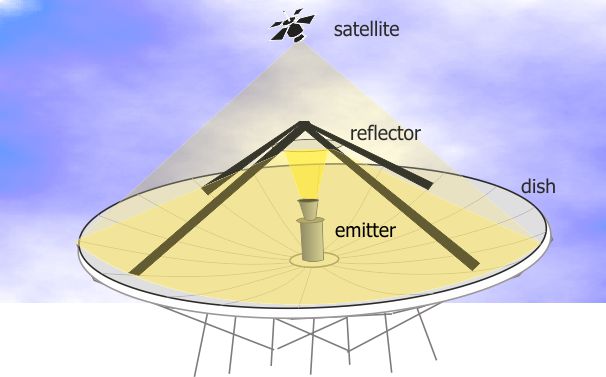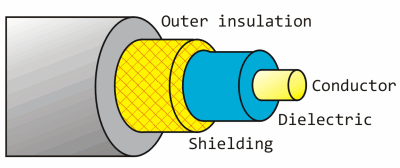Freesat reception - all about dishes
 Brian Butterworth published on UK Free TV
Brian Butterworth published on UK Free TV Satellite reception has both advantages and disadvantages compare with terrestrial (aerial) reception.
By using much higher frequencies (gigahertz, compared to terrestrial televisions megahertz) more transmission channels called transponders (the satellite equivalent of multiplexes) can be provided. For example, there are only six Freeview multiplexes, but Sky or Freesat users can access two hundred satellite transponders.
Aside from exceptional weather conditions (very heavy rain for example) digital satellite provides stable pictures and audio. Where Freeview transmitters are no more than 732 metres above sea level, the geostationary satellites used for television are 35,800,000 metres above the equator so reception is possible even where buildings, trees and hills make terrestrial reception impossible.

The downside of the transmitters being 22,300 miles up in the air is that the signals are very, very weak - so standard TV aerial is of little use. When the signals are sent to the satellites, huge dish transmitters are used to uplink the signal to the satellite. These are tens of metres from side to side, and feature an emitter that generates the signal, which is first bounced of a mirror (called a reflector) and then off the surface of the parabolic dish.

There are many satellites in the sky over the equator. Often these are in clusters over a particular position, for example there are four used for UK television are at 28.2 degrees east. There is another cluster over the 19.2 degrees east positions that are used for German television.
To receive these very weak signals from the satellite, it is necessary to use a dish for reception too. By using a reflective dish, this concentrates the signals onto a small device called a LNB. This is held in front of the dish by a metal arm.

The size of dish for reception is typically much smaller; often 60cm to 100cm in diameter, but the exact size depends upon the transmitting satellite transponder. To keep the transmission power levels down to levels that can be powered by the satellite's solar panels, each beam is focused on a particular area of the Earth's surface. If you are trying to receive the signal at the centre of this zone, a small dish is required. At the outer edges, you may need a 5 metre dish. Maps of these zones are provided by the satellite companies, and are called satellite footprints.
When the dish is installed it must be aligned carefully as the signal is very weak. The installer needs to know the inclination and the azimuth from the ground location to the satellite. If you install yourself you will find that there are markings on the dish that are used to point the dish in the correct position. It is important that the view of the satellite will not be blocked, so must take into account leaves growing on trees and potential building works.
For many people the LNB will have a single cable connected to it, however if you have Sky+ or a multi-room installation the LNB package will actually contain four receivers a quad-LNB. Unlike terrestrial television where you can split the aerial cable to feed more than one Freeview box or television set, with satelite reception you cannot. So, a Sky+ box with two receivers (so you can watch one thing and record another) has two cables connecting the box to the dish.
The cable that connects the dish to the receiver must be satellite grade cable. Whilst this looks superficially like the cable used to connect and aerial to a television, a higher grade cable is required for satellite reception.
Here is an image of a co-axial cable. This sort of cable is used to connect any type of receiving aerial to the reception equipment.

RG6, PF100 and PH100 are all types of coax cable that are suitable for the very weak signals that are received by a satellite dish. (The power is the same as you would receive from a one-bar electric heater on the moon).
The conductor in the centre passes the signals received from the dish to the set-top box. This is made from steel in RG6 cable, and from copper in the RF100 and PH100 types. This makes RG6 less suitable in the UK where rain can damage the cable.
The shielding is responsible for keeping unwanted external interference from damaging the signal. In the cheaper cable this will be a foil wrap, in better specified cables this is a braid (or mesh) of copper wires. The sheild in the RF100 covers 58% of the cable.
The non-conducting layer between the shield and the conductor is called the dielectric. This can be either a solid (RG6), foam (RF100) or air-spaced (PH100) dielectric. This makes the cables progressively more flexible (ie bendy without damage).
3:45 PM
Hello,
there is a satellite box in the front room, connected to a satellite dish on the house.
How do I connect an ordinary TV to the satellite room box?
Thanks
| link to this comment |
9:30 PM
john: It depends on what you mean by "ordinary", is it a normal aerial supplied Freeview or analogue TV? the other points being if the TV is to be used purely via the Sky box, as if so and its in another room then you can run a co-ax lead from the Sky boxes RF output to feed the TV in the other room, which of course will have to be set on analogue if its of the dual standard type. (Digital Freeview / analogue)
| link to this comment |
3:32 PM
is it possible to have(at a cost) sky sports on freesat or freeview
| link to this comment |
5:01 PM
adrian widgery: As far as Freeview is concerned, only if you subscribe to Sky sports 1 or 2 and have a Top up TV Freeview+ set top box.
You cannot access Sky sports etc using a Freesat box.
| link to this comment |
1:27 PM
Hello,
Our rented house has an aerial, but when I plug it into a freeview box, the picture is unwatchable.
We also have a satellite dish. There is a cable coming into the wall which has two ends on it. I was wondering if the £29.99 Bush box at Argos would connect to this cable. I have been told by friends that as I have two cables that I need a more expensive one. Also, is there any way of adapting the two end cable into a one-end cable.
Not bothered about HD or anything, just want basic TV.
| link to this comment |
Nicola: Perhaps you could post a link to a photograph of this cable which has two ends on it.
Poor picture (breaking up) does not necessarily mean that the aerial is not up to scratch. It could be that the TV/box has tuned to a poorer signal than the one that the aerial points to and it could be therefore that which needs rectification (i.e. the TV/box needs tuning to the transmitter to which the aerial points).
If you post your post code it will help give us an idea of what transmitters you could be picking up. It would also help if you could say in which direction your aerial points.
| link to this comment |
2:55 PM
Nicola: The two ended cable you see coming in from the dish (if it definitely is!) is almost guaranteed to have been used by the previous occupiers for Sky+, as this requires two inputs for proper operation.
If you purchase the Bush box you mentioned, which I believe is a BFSAT02SD, then you only require to use one of the leads and leaving the other one unconnected, as these inputs are totally independent of each other, although it could be used at a future date if you purchased a Freesat PVR, as anything that records (via satellite) requires two inputs.
| link to this comment |
7:25 PM
I have freesat+ and recently around 2pm and 7pm the picture starts to go out of focus, or the shoel screen goes red. is this a known phenomen of satellite? i'm new to all this
| link to this comment |
Richard Parker: The most common reason for this would be that your SCART cable is loose. Disconnect it and reconnect it to your equipment, if the problem persists, change the cable.
| link to this comment |
10:16 PM
Hi, I have moved into a house with a sky dish, I have bought a freesat pvr, but it says it needs 2 cables and the dish only has one coming into the house, we can get a very good picture but cant record, I understand it needs to leads, do we have to buy a new box or can we somehow attach another cable to the existing dish ? many thanks
| link to this comment |